Last updated on .
Hasköy is a historic neighborhood along the northern shore of the Golden Horn in Istanbul, Turkey. It’s located in the Beyoğlu district.

Brief History of Hasköy
Hasköy is made up of the words has (fine) and köy (village). It refers to the Ottoman imperial palace and gardens that once stood nearby, now comprised of only Aynalıkavak Pavilion.
The neighborhood has a rich Jewish history dating back to the Byzantine period. It was later settled by Jews expelled from Spain and Portugal in the late 15th century. In the late 16th century, Jews from Eminönü were displaced there for the construction of the New Mosque.
At one time, Hasköy also had a sizable Greek and Armenian population. In fact, the first Armenian theatre company in Istanbul started there in 1858.
Getting to Hasköy
It’s easy to get to Hasköy from Taksim, Eminönü, Tepebaşı or Şişhane by bus, but the most enjoyable way to get there is by ferry. The Golden Horn ferry line runs hourly from Üsküdar and Karaköy to Kasımpaşa, then makes stops at Fener, Balat, Hasköy, Ayvansaray, Sütlüce, and Eyüp.
Hasköy Park
The ferry terminal is located at Hasköy Park (Hasköy Parkı). It’s a wide-open green space with some trees along the Golden Horn. There’s a playground as well as an outdoor fitness center as well as a tea garden. It’s a relaxing place to spend time.
Synagogues in Hasköy
Hasköy was once full of synagogues, although only one is still used regularly by locals. I was able to locate five of the seven while walking through the area. The only two I couldn’t find were the Kula and Sinyora Synagogues, which are both dilapidated.
Esgher Synagogue
The first synagogue I walked by is just across the street from the park, the Esgher Synagogue (Esgher Sinagogu). It was the only synagogue in the coastal area of the neighborhood.
The Esgher Synagogue may have been built in the early 19th century. It was abandoned on July 28, 1948, due to the lack of a congregation and converted to a warehouse. The building was repaired in 1997 and slated to be used as a library, but it was instead converted to a café in 2003.
Mayor Synagogue
Walking uphill on Aziz Street are the remains of the Mayor Synagogue (Mayor Sinagogu). One source claims it was built during the Byzantine period and was called Mayor because it was the biggest synagogue in the area. Another source claims it was built by Jews expelled from Mallorca.
The Mayor Synagogue was in use until the 1960s. It was then converted to a warehouse, and its original appearance has changed significantly.
Karaite Synagogue
Further up the street is the Karaite Synagogue (Karaim Sinagogu). The original building may date back to the 12th century. It was built by a Constantinopolitan Karaite community that spoke Yevanic, a Judaeo-Greek dialect.
The Karaite Synagogue was in ruins by the 16th century and was repaired in 1536. It burned down in 1729, was rebuilt between 1776 and 1780, and was restored in 1842. The synagogue burned down again in 1918 and was promptly rebuilt. Electricity wasn’t added until 1995.
The Karaite Synagogue only functions on the Karaite Passover. To get in touch with the congregation, you can contact the Turkish Chief Rabbinate or the Quincentennial Foundation Museum of Turkish Jews.
Parmakkapı Synagogue
Turning left and walking up Mahlül Street is the Parmakkapı Synagogue (Parmakkapı Sinagogu). It was built by Jews expelled from Spain, but the original construction date is unknown. The synagogue was damaged by fire in 1804 and was allowed to be rebuilt by Sultan Selim III. It was repaired in 1832.
At the beginning of the 20th century, the Parmakkapı Synagogue was the most important synagogue in the area. It also functioned as a meeting hall and stock exchange, and just about every social event in the Jewish community took place there. The congregation began to dwindle in the 1950s until it finally closed to worship.
Maalem Synagogue
The fifth and final synagogue I was able to locate is the Maalem Synagogue (Maalem Sinagogu). It was built by Spanish Jews in the 18th century. Part of the interior is shaped like a ship’s bow, symbolizing immigration from Spain.
The only remaining regularly active synagogue in Hasköy, the Maalem Synagogue is open to visitors on weekdays. Visits must be scheduled in advance through the Turkish Chief Rabbinate or the Quincentennial Foundation Museum of Turkish Jews.
Agia Paraskevi Orthodox Church
One building I didn’t have time to visit was the Agia Parasekevi Greek Orthodox Church (Aya Paraskevi Rum Ortodoks Kilisesi). It was built by the Greek Orthodox community in Hasköy in 1692, and underwent an extensive restoration in 1833 and again in 1958. The Ecumenical Patriarchate of Constantinople in Fener allocated the church to the Romanian community of Istanbul.